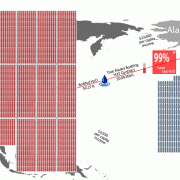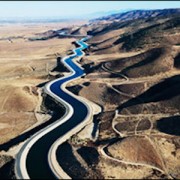Peter Gleick: Zombie Water Projects (Just when you thought they were really dead…)
Zombies are big business, in more ways than one. Zombie books, movies, costumes, make-up, computer games, and more are probably worth billions to our economy, not to mention the value of extra sales of axes, chainsaws, and shotguns to people who never hunt or cut down trees.
But not all zombies are fictional, and some are potentially really dangerous – at least to our pocketbooks and environment. These include zombie water projects: large, costly water projects that are proposed, killed for one reason or another, and are brought back to life, even if the project itself is socially, politically, economically, and environmentally unjustified.
Here are four kinds of zombie water projects that have been repeatedly beaten down for a variety of reasons but that keep rearing their ugly heads. Keep those chainsaws lubed and fueled:
1. Water transfers from the Great Lakes or the Mississippi River or Alaska and Canada to the arid southwestern U.S.
These are perennial favorites: people look at the vast amount of water in the Great Lakes, or flowing down the Mississippi River, or flowing north to the Arctic Ocean and think, gee, what could make more sense than to take that water and move it to where we really need it, like California or Arizona or Las Vegas. After all, we’ve been moving water around since the beautifully designed Roman aqueducts, and even earlier. But most of these mega-projects are zombies – killed off years ago, only to linger, undead.
Patricia Mulroy, who runs the Southern Nevada Water Authority, recently revived the idea of moving floodwaters from the Mississippi River all the way to Colorado, New Mexico, and Arizona to free up Colorado River water that could then be given to feed Las Vegas. Fear that similar projects would take water out of the Great Lakes led to a provision in the new international agreement signed by the U.S. and Canada that effectively prohibits transfers of water out of the basin because of fear that such diversions would lower the Great Lakes levels and threaten the health of fragile natural ecosystems. And of course there is the granddaddy of all water diversion proposals – called NAWAPA (the North American Water and Power Alliance) – proposed in the late 1950s and early 1960s by a consulting/construction company to divert around 150 million acre-feet of water annually (ten times the flow of the Colorado River) from the Yukon, Copper, Kootenay, Fraser, Peace, and other Alaskan/Canadian rivers all the way east to the Great Lakes and south to the southwestern U.S. and even Mexico. And a smaller version of this zombie is the Million Conservation Research Group proposal (named after Aaron Million – if it had anything to do with the cost, it would be the Billion Conservation Research Group) to build a pipeline from Wyoming to eastern Colorado to take 250,000 acre-feet of public water to sell for private gain. Professor Robert Glennon from the University of Arizona quipped that he sees many obstacles to the project, “not the least of which is the Rocky Mountains.”
These mega-projects are certainly technically feasible: there’s no mystery to building dams, aqueducts, pumping plants, and pipelines. What kills these projects is their massive political, environmental, and economic cost. They would cost tens or even hundreds of billions of dollars and lead to vast environmental destruction and devastation. Half a century ago, we didn’t know about the ecological consequences of massive water diversions, or we didn’t care, but those days are over. On top of this, any such project would require unprecedented political and legal water sharing agreements and anyone who believes such agreements can be reached is living in a fantasyland. But that doesn’t stop these zombies from periodically coming back to life.
2. Water transfers from Alaska or Norway or the Arctic/Antarctic to Asia or the Middle East through the ocean
An international version of the major pipeline or aqueduct projects described above is the idea of putting water in tankers or big plastic bags and shipping it overseas (or, the earliest version – towing icebergs). The most recent example is the proposal to ship water from Sitka, Alaska to Asia or even the Middle East. Once again, a logical idea runs smack into the wall of economics, though for some reason, these water entrepreneurs seem blind to economics. In this case, the proposed price is around $0.01 per gallon. The water would be put into tankers or water bags and shipped overseas. [I don’t believe that they can actually ship water from Alaska to the Middle East, or even closer, to Asia, for $0.01 per gallon, but let’s assume, for the moment, that they can.] Let’s do a simple back-of-the-envelope calculation that seems to be beyond the ken of those pushing the project: $0.01 per gallon is equal to $2.64 per cubic meter. The current price of coastal desalination, which produces highly pure water, varies from place to place, but is already well below $2 per cubic meter. Why would any buyer agree to buy more expensive water, of no better quality, from someone else when they could build a desalination plant under their own control? So far, none have. But expect to see this zombie staggering around periodically.
3. The Poseidon Carlsbad desalination project
Having just argued that desalination makes more sense than water transfers through the ocean from water-rich to water-poor regions, it turns out that notall desalination plants make sense. It is a proven technology – thousands of desalination plants are operating around the world – but it is a costly one to do properly. An effort by a private development group, Poseidon Resources, to build a plant at Carlsbad, near San Diego, has become the textbook case of how NOT to build a desalination plant (ironically replacing the previous textbook case of how not to build a desalination plant – Poseidon’s earlier venture with the Tampa Bay desalination plant in Florida). The Carlsbad plant was originally projected to cost around $270 million. A year ago, the costs had risen so much that Poseidon was trying to get $530 million in tax-free bonds to help them finance the project, on top of a massive subsidy from local water agencies. A month ago, they filed a new application for $780 million in tax exempt bonds, suggesting the cost is approaching a billion dollars. The company’s current estimate is that the cost of delivered desalination water has skyrocketed over the past few years to around $2000 per acre-foot, which is nearly triple San Diego’s current supply costs. And their design is still controversial because of concerns about location, environmental impacts, and financing. Moreover, the complete lack of transparency about contracts, permit decisions by local governments, Poseidon financial structure and funders, and the true economics of the plant have soured even strong proponents of desalination. This zombie refuses to die only because outside investors (either unbelievably gullible or incredibly smart) keep putting in money.
4. The Cadiz groundwater mining project
Another effort to turn a public water resource into a private good is the Cadiz Valley Water Conservation, Recovery and Storage Project (or the Cadiz groundwater mining project). This project is the brainchild of another private investment group and hopes to mine groundwater from an aquifer located in the eastern Mojave Desert in San Bernardino County. This project is unsustainable: it takes more groundwater out than nature recharges. Over time, this will result in disappearance of surface springs and ephemeral water in desert lake beds, and a declining groundwater level. In other words, the project exchanges public goods for private gain. An earlier version of the project, not much different from the current one, was killed by the Metropolitan Water District of Southern California because of environmental and economic concerns, but like a water zombie, Cadiz has come back to life. A new draft Environmental Impact Statement has just been released, but beware: it is 305 megabytes in size, which makes it pretty much impossible for normal citizens to download it and read it to find out if it needs to be tackled with an axe or a chainsaw.
There are many smart water investments to be made, in industrial and agricultural water-efficiency technologies, better wastewater treatment plants capable of producing the highest quality waters, improved piping and distribution systems, lower energy desalination systems, improved monitoring tools, low-water-using crop types, and much more. But wasting precious time and scarce money on water zombies will not lead to a sustainable water future.
Peter Gleick
Originally published by the Forbes on December 7, 2011.







Hopefully, after the judge rules (and all of the appeals are exhausted), the Northern Nevada-Las Vegas pipeline project will ALSO join this cautionary list.